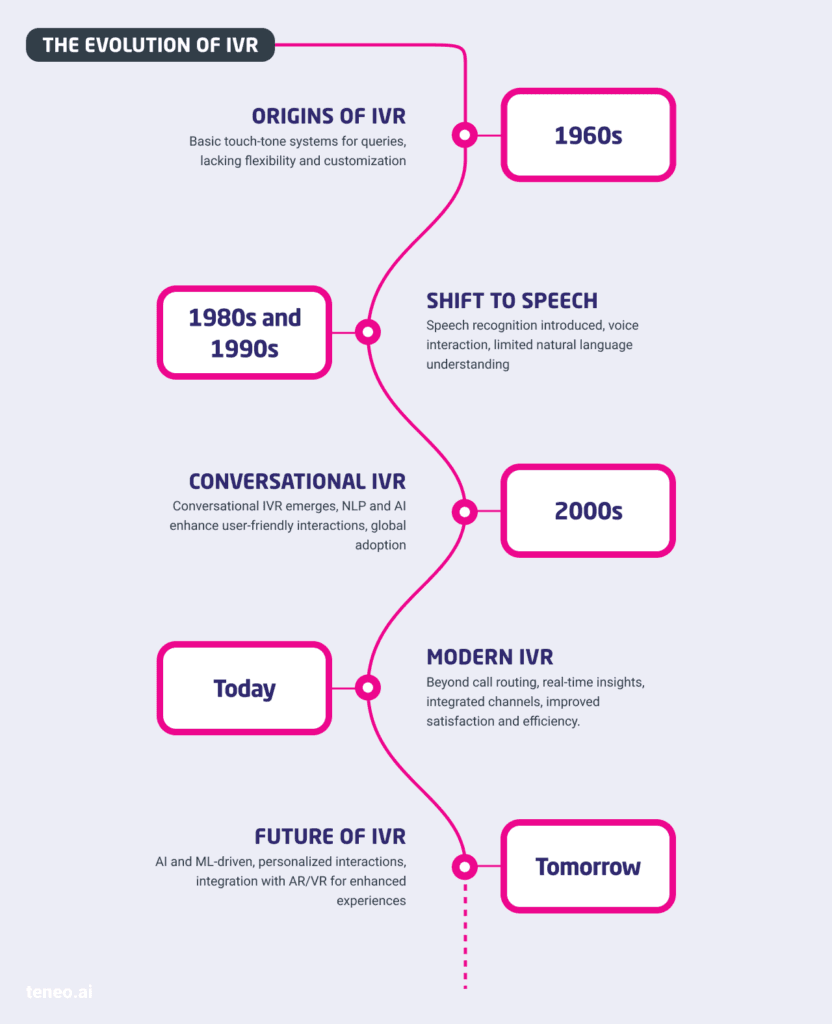Interactive voice response (IVR) systems have evolved from frustrating menu trees to sophisticated conversational interfaces that transform customer experience while dramatically reducing operational costs. Today’s leading organizations are leveraging advanced IVR technology to achieve 40% cost reduction and 30% higher satisfaction scores simultaneously.
At Teneo, we’ve pioneered conversational IVR solutions that understand natural language, adapt to customer needs, and deliver personalized experiences that drive satisfaction and loyalty. Our proprietary technology helps organizations across healthcare, financial services, retail, and telecommunications solve their most pressing customer service challenges.
Whether you’re looking to modernize an outdated IVR system, reduce contact center costs, or transform your customer experience, Teneo’s conversational IVR solutions provide the intelligence, flexibility, and reliability you need to succeed.
Transform Your Customer Experience with Teneo IVR
Join the leading enterprises achieving 40% cost reduction and 30% higher satisfaction scores. We help high-growth companies like Telefonica, HelloFresh and Swisscom find new opportunities through AI conversations.
Introduction to IVR
Interactive Voice Response (IVR) is a technology that allows a computer to interact with humans through voice and DTMF tones input via a keypad. In its most basic form, IVR provides a menu system that enables callers to select options using either their voice or keypad, routing them to the appropriate destination or information.
Modern IVR systems have evolved significantly from their early days of simple menu trees. Today’s advanced IVR solutions leverage artificial intelligence, natural language understanding, and integration with backend systems to create conversational experiences that can understand intent, maintain context, and deliver personalized responses.
What is an IVR?
An IVR system is a telecommunication technology that allows customers to interact with an organization’s telephone system using their voice or touch-tone keypad. The system can route calls to the appropriate department or agent, provide automated responses, or offer self-service options for common queries. IVR systems are designed to handle high call volumes, streamline call routing, and improve customer satisfaction by reducing wait times.
New to IVR technology?
Download our comprehensive guide to modern IVR solutions and discover how they can transform your customer experience.
The Evolution of IVR
The journey of IVR technology spans several decades, with each evolution bringing significant improvements in functionality, user experience, and business value:

For a more comprehensive overview of the history of the technology, enjoy our dedicated article, here.
Why Teneo’s Approach to IVR Stands Apart
In a market saturated with IVR solutions, Teneo has established itself as the industry leader through our unique approach to conversational AI. While other providers offer incremental improvements to traditional IVR systems, Teneo has reimagined voice interactions from the ground up.
Proprietary NLU Engine Built for Voice
At the core of Teneo’s IVR superiority is our proprietary Natural Language Understanding (NLU) engine specifically optimized for voice interactions. Unlike general-purpose AI models, our technology:
- Achieves 99% intent recognition accuracy even with background noise
- Understands 86 different accents and dialects without additional training
- Processes contextual understanding across multi-turn conversations
- Adapts to industry-specific terminology without extensive customization
This specialized approach means your customers are understood the first time, reducing frustration and call abandonment rates by an average of 34%.
Seamless Integration Ecosystem
Teneo’s OpenQuestion platform sits at the center of our integration ecosystem, connecting seamlessly with:
CCaaS Platforms
Amazon Connect, Genesys Cloud CX, NICE CXone, and more
CRM systems
Salesforce, Microsoft Dynamics, ServiceNow, and others.
Enterprise systems
SAP, Oracle, custom databases, and legacy platforms.
This integration flexibility means you can implement Teneo’s advanced IVR capabilities without replacing your existing technology investments—reducing implementation time by 60% compared to competitors.
Hybrid AI Approach
While many vendors force you to choose between rules-based systems or pure machine learning, Teneo’s hybrid approach gives you the best of both worlds:
| Teneo Hybrid AI | Rules-Only Systems | Pure ML Systems | |
|---|---|---|---|
| Deterministic Control | ✓ | ✓ | ✗ |
| AI Flexibility | ✓ | ✗ | ✓ |
| Continuous Learning | ✓ | ✗ | ✓ |
| Human-in-the-loop | ✓ | ✓ | Limited |
This balanced methodology delivers 99.7% uptime while continuously improving performance—a combination our clients consistently rate as superior to other solutions they’ve implemented.
How NLU Advances IVR Technology
Natural Language Understanding (NLU) represents the most significant advancement in IVR technology, transforming how systems interpret and respond to human speech. Unlike traditional speech recognition that simply converts speech to text, NLU extracts meaning, intent, and context from natural language inputs.
This capability enables IVR systems to understand what customers want to accomplish, even when they express it in different ways. For example, “I want to check my balance,” “How much money do I have in my account?” and “What’s my current balance?” all represent the same intent but would confuse traditional IVR systems.
Advanced NLU also enables:
- Multi-intent recognition: Understanding when a customer has multiple requests in a single statement
- Entity extraction: Identifying specific information like dates, account numbers, or product names within natural speech
- Sentiment analysis: Detecting customer emotions to adapt responses accordingly
- Contextual understanding: Maintaining conversation history to provide relevant responses
Experience the power of NLU in action
See how Teneo’s Natural Language Understanding can transform your customer interactions with our interactive demo.
Benefits of Modern IVR Systems
Today’s conversational IVR systems deliver significant benefits across multiple dimensions:
Cost Reduction
Modern IVR systems can handle 60-80% of routine inquiries without agent intervention, reducing operational costs by 30-40% while maintaining high customer satisfaction.
Improved Efficiency
Conversational IVR reduces average handle time by 25-35% through faster intent recognition and streamlined authentication, allowing more customers to be served in less time.
Enhanced Customer Experience
Natural language interfaces eliminate frustrating menu trees, allowing customers to express their needs in their own words and receive immediate assistance.
24/7 Availability
IVR systems provide consistent service quality around the clock, ensuring customers can get assistance whenever they need it without waiting for available agents.
Data-Driven Insights
Modern IVR systems capture valuable customer interaction data that can be analyzed to identify trends, common issues, and opportunities for service improvement.
Personalized Service
Integration with CRM and other systems allows IVR to recognize customers, access their history, and provide personalized responses based on their specific situation.
Real-World Success: How Organizations Are Transforming with Teneo IVR
Leading organizations across industries are achieving remarkable results with Teneo’s conversational Interactive Voice Response solutions. Here’s how they’re transforming their customer experience while reducing costs.
Telefónica Implements Teneo Conversational IVR to Support Industry-Leading Contact Center Customer Experience
The Results
+6%
Increase in IVR resolution rate
+900K
Monthly calls and +200k monthly text requests handled
+200K
Monthly text request handled
+400
Generic use cases created
+20
Personalized use cases created
The Challenge
In 2017-2018, Telefónica Germany was accused of delivering an
extremely low level of customer service via its Contact Centers. Customers were unable to connect to customer services over the phone in order to resolve key issues and there was a distinctive lack of solution-based information available via other channels such as email, text and social media.
The Solution
With the support of Teneo.ai and its SaaS solution, Teneo Conversational IVR, Telefónica Germany owns one of the most complex solutions seen
within the telecommunications industry. Telefónica’s fully operational solution operates across all channels to realize a consistent omnichannel experience, increase customer satisfaction and create the potential of personalized sales opportunities.

A project like this doesn’t just come to life from nothing. There needs to be a vision from product marketing and to senior management because you need to get buy in from multiple stakeholders. Innovation is not free, so you need to invest in technology and in your team in order to execute on your vision and plan for the future.
Sarah Rojewski
Manager of A.I. and Automation, Telefónica Germany
The Future of Interactive Voice Response Technology
The IVR landscape continues to evolve rapidly, with several emerging trends shaping the future of voice interactions:
Multimodal Experiences
Future IVR systems will seamlessly blend voice with visual elements, allowing customers to start interactions by phone and continue on digital channels without losing context.
Emotion AI
Advanced systems will detect customer emotions through voice analysis and adapt responses accordingly, providing more empathetic and effective service.
Proactive Engagement
IVR systems will evolve from reactive to proactive, initiating outbound communications for appointment reminders, fraud alerts, and personalized offers.
Voice Biometrics
Voice authentication will become the standard for secure, frictionless verification, eliminating the need for PINs, passwords, or security questions.
Ambient Intelligence
Interactive Voice Response capabilities will extend beyond phone calls to smart speakers, cars, and other voice-enabled devices, creating consistent experiences across all voice touchpoints.
Teneo IVR Solutions: The Future of Voice Interaction
Teneo offers a comprehensive suite of Interactive Voice Response solutions designed to transform your voice channel from a cost center to a competitive advantage. Our solutions combine advanced AI capabilities with enterprise-grade reliability to deliver exceptional customer experiences.
Key Capabilities
Natural Language Understanding
Our proprietary NLU engine understands customer intent from natural speech with 99% accuracy—even with background noise, accents, or industry-specific terminology. Customers can speak naturally and be understood the first time, eliminating the frustration of traditional IVR systems.
Contextual Awareness
Teneo Conversational IVR maintains context throughout the customer journey, remembering previous interactions and adapting responses accordingly. This creates truly conversational experiences where customers don’t need to repeat information or navigate through irrelevant options.
Omnichannel Integration
Our solution seamlessly connects voice interactions with digital channels, allowing conversations to move between phone, web, mobile, and messaging without losing context. Start a transaction on the phone and complete it via text message with perfect continuity.
Implementation Approach
- Discovery Workshop: We analyze your current call flows, identify high-impact automation opportunities, and define success metrics.
- Design & Development: Our conversation designers and AI engineers build your custom solution using our pre-built industry accelerators.
- Integration & Testing: We seamlessly integrate with your existing systems and rigorously test with real-world scenarios.
- Deployment & Optimization: We deploy your solution and continuously optimize performance based on actual customer interactions.
Most implementations are completed within 8-12 weeks, with initial modules live in as little as 4 weeks.
Business Impact
Organizations implementing Teneo Conversational IVR typically achieve:
- 30-40% reduction in operational costs
- 25-35% improvement in first-call resolution
- 15-25% increase in customer satisfaction scores
- 50-70% decrease in call abandonment rates

